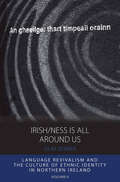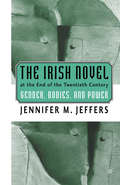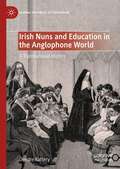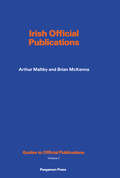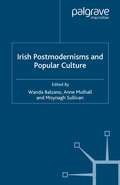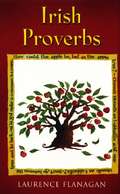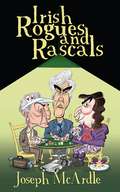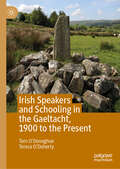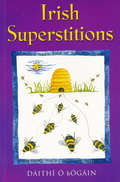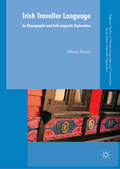- Table View
- List View
Irish National Cinema (National Cinemas)
by Ruth BartonFrom the international successes of Neil Jordan and Jim Sheridan, to the smaller productions of the new generation of Irish filmmakers, this book explores questions of nationalism, gender identities, the representation of the Troubles and of Irish history as well as cinema's response to the so-called Celtic Tiger and its aftermath. Irish National Cinema argues that in order to understand the unique position of filmmaking in Ireland and the inheritance on which contemporary filmmakers draw, definitions of the Irish culture and identity must take into account the so-called Irish diaspora and engage with its cinema. An invaluable resource for students of world cinema.
Irish Nationalists and the Making of the Irish Race
by Bruce NelsonThis is a book about Irish nationalism and how Irish nationalists developed their own conception of the Irish race. Bruce Nelson begins with an exploration of the discourse of race--from the nineteenth--century belief that "race is everything" to the more recent argument that there are no races. He focuses on how English observers constructed the "native" and Catholic Irish as uncivilized and savage, and on the racialization of the Irish in the nineteenth century, especially in Britain and the United States, where Irish immigrants were often portrayed in terms that had been applied mainly to enslaved Africans and their descendants. Most of the book focuses on how the Irish created their own identity--in the context of slavery and abolition, empire, and revolution. Since the Irish were a dispersed people, this process unfolded not only in Ireland, but in the United States, Britain, Australia, South Africa, and other countries. Many nationalists were determined to repudiate anything that could interfere with the goal of building a united movement aimed at achieving full independence for Ireland. But others, including men and women who are at the heart of this study, believed that the Irish struggle must create a more inclusive sense of Irish nationhood and stand for freedom everywhere. Nelson pays close attention to this argument within Irish nationalism, and to the ways it resonated with nationalists worldwide, from India to the Caribbean.
Irish Nationalists and the Making of the Irish Race
by Bruce NelsonThis is a book about Irish nationalism and how Irish nationalists developed their own conception of the Irish race. Bruce Nelson begins with an exploration of the discourse of race--from the nineteenth--century belief that "race is everything" to the more recent argument that there are no races. He focuses on how English observers constructed the "native" and Catholic Irish as uncivilized and savage, and on the racialization of the Irish in the nineteenth century, especially in Britain and the United States, where Irish immigrants were often portrayed in terms that had been applied mainly to enslaved Africans and their descendants. Most of the book focuses on how the Irish created their own identity--in the context of slavery and abolition, empire, and revolution. Since the Irish were a dispersed people, this process unfolded not only in Ireland, but in the United States, Britain, Australia, South Africa, and other countries. Many nationalists were determined to repudiate anything that could interfere with the goal of building a united movement aimed at achieving full independence for Ireland. But others, including men and women who are at the heart of this study, believed that the Irish struggle must create a more inclusive sense of Irish nationhood and stand for freedom everywhere. Nelson pays close attention to this argument within Irish nationalism, and to the ways it resonated with nationalists worldwide, from India to the Caribbean.
An Irish Navvy – The Diary of an Exile: The Diary Of An Exile
by Donall MacAmhlaighDIrish construction workers in post-war Britain are celebrated in song and story. Donall MacAmhlaigh kept a diary as he worked the sites, danced in the Irish halls, drank in Irish pubs and lived the life of the roving Irish navvy. Work was hard, dirty and dangerous, followed by pints in the Admiral Rodney, the Shamrock, the Cattle Market Tavern and others. Living conditions were basic at best. This vivid picture of an Irish navvy's life in England in the 1950s mirrors that of an entire generation who left Ireland without education or hope. Days without food or work, the hardships of work camps, lonesome partings after trips home, periods of intense isolation and bitter reflection were all part of the experience. • Also available: Hard Road to Klondike.
Irish/ness Is All Around Us: Language Revivalism and the Culture of Ethnic Identity in Northern Ireland (Integration and Conflict Studies #6)
by Olaf ZenkerFocusing on Irish speakers in Catholic West Belfast, this ethnography on Irish language and identity explores the complexities of changing, and contradictory, senses of Irishness and shifting practices of 'Irish culture' in the domains of language, music, dance and sports. The author’s theoretical approach to ethnicity and ethnic revivals presents an expanded explanatory framework for the social (re)production of ethnicity, theorizing the mutual interrelations between representations and cultural practices regarding their combined capacity to engender ethnic revivals. Relevant not only to readers with an interest in the intricacies of the Northern Irish situation, this book also appeals to a broader readership in anthropology, sociology, cultural studies, history and political science concerned with the mechanisms behind ethnonational conflict and the politics of culture and identity in general.
The Irish Novel at the End of the Twentieth Century: Gender, Bodies and Power
by J. JeffersThe Irish Novel at the End of the Twentieth Century: Gender, Bodies and Power interprets a wide variety of the most interesting Irish novels of the last ten years of the century from a perspective that focuses on the regulated sexual and constructed gendered body. The demarcating line of identity-the perennial Irish problem-can be gauged at the basic level of sexual and gender identity in contrast to or in alliance with political, social, religious or cultural norms. All mechanisms that have gone into controlling the body-gender regulation, violence, desire, religious taboos-can all be reinterpreted through the body in motion.
Irish Nuns and Education in the Anglophone World: A Transnational History (Global Histories of Education)
by Deirdre RafteryThis book charts the history of how Irish-born nuns became involved in education in the Anglophone world. It presents a heretofore undocumented study of how these women left Ireland to establish convent schools and colleges for women around the globe. It challenges the dominant narrative that suggests that Irish teaching Sisters, also commonly called nuns, were part of the colonial project, and shows how they developed their own powerful transnational networks. Though they played a role in the education of the ‘daughters of the Empire’, they retained strong bonds with Ireland, reproducing their own Irish education in many parts of the Anglophone world.
Irish Official Publications: A Guide to Republic of Ireland Papers, with a Breviate of Reports 1922–1972
by Arthur Maltby Brian McKennaGuides to Official Publications, Volume 7: Irish Official Publications provides a compilation of guidelines and summaries concerning Irish official publications. This book examines the bibliographical mysteries surrounding Republic of Ireland government publications. Organized into 10 classes, this book begins with an overview of the various categories of Irish official publications. This text then indicates how Irish official publications may be traced and acquired, and lists some libraries with good collections. This book discusses as well some important background information in terms and symbols and specimen pages are included to illustrate the transition of a serial from the British to the Free State administration. The reader is also introduced to the weekly and annual lists of government publications together with an example of a State-sponsored document. This book is a valuable resource for students and teachers.
The Irish Parading Tradition: Following the Drum (Ethnic and Intercommunity Conflict)
by T. FraserThe book examines the evolution and current significance of the parading tradition in Ireland. Since 1995, confrontations over parades have existed side by side with the Northern Ireland peace process. The most bitter of these have occurred over the Drumcree church parade at Portadown and the Relief of Derry parades. Using a range of historical and anthropological perspectives, the book traces the parading tradition from the seventeenth century to the present.
The Irish Paradox: How and Why We Are Such a Contradictory People
by Sean MoncrieffWhat does it mean to be Irish?‘We’ve been clever and stupid, principled and corrupt. We can be kind and cruel, guilty of dopey optimism and chronic fatalism. We’re friendly, but near impossible to get to know. We’re proud to be Irish but often crippled with self-loathing. We think we’re great, but not really. We find ourselves fascinating. Of course we do. We’re a paradox.’There’s something about Irish people, about the way their minds work. But what does it mean to be Irish?In his search for the key to the Irish psyche, Sean Moncrieff roams far and wide – from the pub to the dole queue, the laboratory to the pulpit. Packed with offbeat anecdotes, observations and intriguing detours into the murkier recesses of Irish history and culture, The Irish Paradox is a roadmap for those struggling to make sense of a country defined as much by its contradictions as its sense of community.
Irish Postmodernisms and Popular Culture
by Wanda BalzanoThis collection explores popular culture in Ireland and Ireland in popular culture, from Fanfic to Orange Parades; from boybands to the Blessed Virgin Mary; from celebrity tourism to the Gaelic Athletic Association. The essays examine local and global Irishness, focusing on how gender, sexuality and race shape Irish 'postmodernity'.
The Irish Protestant Churches in the Twentieth Century
by Alan MegaheyThis book is unique in recording the history of all the Protestant churches in Ireland in the twentieth century, though with particular focus on the two largest - the Presbyterian and the Church of Ireland. It examines the changes and chances in those churches during a turbulent period in Irish history, relating their development to the wider social and political context. Their structures and beliefs are examined, and their influence both in Ireland and overseas is assessed.
Irish Proverbs: A Collection of Irish Proverbs, Old and New
by Laurence FlanaganThere are millions of Irish proverbs, old and new, and Laurence Flanagan has made a wide-ranging collection of these proverbs, some well known, some obscure, and has provided both Irish and English text for them.
Irish Religious Conflict in Comparative Perspective: Catholics, Protestants and Muslims (Histories of the Sacred and Secular, 1700-2000)
by John WolffeBy setting the Irish religious conflict in a wide comparative perspective, this book offers fresh insights into the causes of religious conflicts, and potential means of resolving them. The collection mounts a challenge to views of 'Irish exceptionalism' and points to significant historical and contemporary commonalities across the Western world.
Irish Rogues and Rascals – From Francis Shackleton to Charlie Haughey: The Hilarious Stories of Ireland’s Most Notorious Chancers
by Joseph McArdleIrish history is littered with rogues, larger-than-life characters who range from cheeky scamps to vicious chancers. In Irish Rogues and Rascals, Joseph MacArdle looks at some of the most notorious Irishmen to find out just exactly what a ‘rogue’ is.Is it a dastardly knave, a cheeky rascal or a devilish trickster? Is it a lovable scamp or is it someone who is charming and delightful but with a bit of mischievousness and sauciness thrown into the mix as well? Whatever the answer, the fascinating collection of Irish rogues in Joseph McArdle’s hilarious book Irish Rogues and Rascals embraces vicious chancers at one extreme and lovable imps at the other.These Irish rogues and rascals range from Myler Magrath, a sixteenth-century character who loved wine, women and money – and who was both Catholic Bishop of Down and Connor and Protestant Archbishop of Cashel at the same time through to Tiger Roche, the infamous eighteenth-century rake and duellist who drank and fought his way from Ireland to Cape Town.They include more modern figures such as Paul Singer, a fraudster who tricked countless people out of their hard-earned money in the 1950s, and Des Traynor, the mastermind of Irish tax evasion schemes for much of the late twentieth century , and not forgetting the most accomplished political rogue of modern times, Charles J. Haughey.Joseph McArdle writes with affection about his colourful rogues, usually seeing more to admire in their cleverness and brazenness than to deplore in the results of their conduct. His rogues may not always be honourable – but they usually are fun and their stories make compelling reading.Irish Rogues and Rascals: Table of ContentsPrefaceThe spinning bishop: Myler Magrath Eighteenth-century rogues: Garrett Byrne, James Strange, John M’NaghtanFighting Fitzgerald: George Robert Fitzgerald This wicked prelate: Frederick Hervey, Bishop of DerryTiger Roche and the giant wheelThe jewels in the crowns: Colonel Blood and Francis ShackletonThe Sinn Fein irreconcilable: Robert Erskine Childers Speak some good of the dead: John DeLorean The deadly charmer: James H. Lehman The man with the golden touch: Paul SingerTear him for his bad verses: Francis StuartThe tribunal rogues: Charles Haughey, Des Traynor, Patrick Gallagher, Ray Burke, Liam Lawlor
Irish Speakers and Schooling in the Gaeltacht, 1900 to the Present
by Tom O'Donoghue Teresa O'DohertyThis book offers the first full-length study of the education of children living within the Gaeltacht, the Irish-speaking communities in Ireland, from 1900 to the present day. While Irish was once the most common language spoken in Ireland, by 1900 the areas in which native speakers of Irish were located contracted to such an extent that they became clearly identifiable from the majority English-speaking parts. In the mid-1920s, the new Irish Free State outlined the broad parameters of the boundaries of these areas under the title of ‘the Gaeltacht’. This book is concerned with the schooling of children there. The Irish Free State, from its establishment in 1922, eulogized the people of the Gaeltacht, maintaining they were pious, heroic and holders of the characteristics of an invented ancient Irish race. Simultaneously, successive governments did very little to try to regenerate the Gaeltacht or to ensure Gaeltacht children would enjoy equality of education opportunity. Furthermore, children in the Gaeltacht had to follow the same primary school curriculum as was prescribed for the majority English speaking population. The central theme elaborated on throughout the book is that this schooling was one of a number of forces that served to maintain the people of the Gaeltacht in a marginalized position in Irish society.
Irish Stereotypes in Vaudeville, 1865-1905 (Palgrave Studies in Theatre and Performance History)
by Jennifer MooneyVaudeville is often viewed as the source of some of the crude stereotypes that positioned the Irish immigrant in America as the antithesis of native-born American citizens. Using primary archival material, Mooney argues that the vaudeville stage was an important venue in which an Irish-American identity was constructed, negotiated, and refined.
Irish Superstitions: Irish Spells, Old Wives’ Tales and Folk Beliefs
by Dáithí Ó hÓgáinDáithí Ó hÓgáin, one of Ireland’s leading folklorists, gives a lively and informative account of the widespread folk beliefs of Ireland in Irish Superstitions, this popular guide to Irish superstitions, old wives’ tales and other spooky stuff from the Irish countryside.Irish Superstitions includes a list of good-luck charms, spells, soothsayings and other irrational but charming and creative folk beliefs. There are stories of leprechauns and sprites, ghosts, the evil eye and wise women’s curses. There are also charms and spells to make crops grow, to keep cattle healthy, to ensure safe childbirth, and to fulfil many other longed-for desires. Most of the superstitions are of pagan origin; many were overlaid with popular Christian belief.Irish Superstitions: Table of ContentsForeword — The Mind EngagedMan the Summation of All ThingsThe World Around UsOurselves and the OthersRules and Practices of Life
The Irish tower house: Society, economy and environment, <i>c.</i> 1300–1650 (Social Archaeology and Material Worlds)
by Victoria L. McAlisterThis book examines the social role of castles in late-medieval and early modern Ireland. It uses a multidisciplinary methodology to uncover the lived experience of this historic culture, demonstrating the interconnectedness of society, economics and the environment. Of particular interest is the revelation of how concerned pre-modern people were with participation in the economy and the exploitation of the natural environment for economic gain. Material culture can shed light on how individuals shaped spaces around themselves, and tower houses, thanks to their pervasiveness in medieval and modern landscapes, represent a unique resource. Castles are the definitive building of the European Middle Ages, meaning that this book will be of great interest to scholars of both history and archaeology.
The Irish tower house: Society, economy and environment, <i>c.</i> 1300–1650 (Social Archaeology and Material Worlds)
by Victoria L. McAlisterThis book examines the social role of castles in late-medieval and early modern Ireland. It uses a multidisciplinary methodology to uncover the lived experience of this historic culture, demonstrating the interconnectedness of society, economics and the environment. Of particular interest is the revelation of how concerned pre-modern people were with participation in the economy and the exploitation of the natural environment for economic gain. Material culture can shed light on how individuals shaped spaces around themselves, and tower houses, thanks to their pervasiveness in medieval and modern landscapes, represent a unique resource. Castles are the definitive building of the European Middle Ages, meaning that this book will be of great interest to scholars of both history and archaeology.
Irish Traveller Language: An Ethnographic and Folk-Linguistic Exploration (Palgrave Studies in Minority Languages and Communities)
by Maria RiederThis book explores the Irish Traveller community through an ethnographic and folk linguistic lens. It sheds new light on Irish Traveller language, commonly referred to as Gammon or Cant, an integral part of the community’s cultural heritage that has long been viewed as a form of secret code. The author addresses Travellers’ metalinguistic and ideological reflections on their language use, providing deep insights into the culture and values of community members, and into their perceived social reality in wider society. In doing so, she demonstrates that its interrelationship with other cultural elements means that the language is in a constant flux, and by analysing speakers’ experiences of language in action, provides a dynamic view of language use. The book takes the reader on a journey through oral history, language naming practices, ideologies of languageness and structure, descriptions of language use and contexts, negotiations of the ‘authentic’ Cant, and Cant as ‘identity’. Based on a two-year ethnographic fieldwork project in a Traveller Training Centre in the West of Ireland, this book will appeal to students and scholars of sociolinguistics, language in society, language ideology, folk linguistics, minority communities and languages, and cultural and linguistic anthropology.
Irish women in medicine, c.1880s–1920s: Origins, education and careers
by Laura KellyAvailable in paperback for the first time, this book is the first comprehensive history of Irish women in medicine in the late nineteenth and early twentieth centuries. It focuses on the debates surrounding women’s admission to Irish medical schools, the geographical and social backgrounds of early women medical students, their educational experiences and subsequent careers. It is the first collective biography of the 760 women who studied medicine at Irish institutions in the period and, in contrast to previous histories, puts forward the idea that women medical students and doctors were treated fairly and often favourably by the Irish medical hierarchy. It highlights the distinctiveness of Irish medical education in contrast with that in Britain and is also unique in terms of the combination of rich sources it draws upon, such as official university records from Irish universities, medical journals, Irish newspapers, Irish student magazines, the memoirs of Irish women doctors, and oral history accounts.
Irish women in medicine, c.1880s–1920s: Origins, education and careers
by Laura KellyAvailable in paperback for the first time, this book is the first comprehensive history of Irish women in medicine in the late nineteenth and early twentieth centuries. It focuses on the debates surrounding women’s admission to Irish medical schools, the geographical and social backgrounds of early women medical students, their educational experiences and subsequent careers. It is the first collective biography of the 760 women who studied medicine at Irish institutions in the period and, in contrast to previous histories, puts forward the idea that women medical students and doctors were treated fairly and often favourably by the Irish medical hierarchy. It highlights the distinctiveness of Irish medical education in contrast with that in Britain and is also unique in terms of the combination of rich sources it draws upon, such as official university records from Irish universities, medical journals, Irish newspapers, Irish student magazines, the memoirs of Irish women doctors, and oral history accounts.
The Irish Women’s Movement: From Revolution to Devolution
by Linda ConnollyThis book provides a comprehensive analysis of the emergence, consolidation and development of the Irish women's movement, as a social movement, in the course of the twentieth century. It seek to address several lacunae in Irish studies by illuminating the processes through which the movement and, in particular, networks of constituent organisations, came to fruition as agencies of social change. The central argument advanced is that when viewed historically, the Irish women's movement is characterised by its interconnectedness and continuity: the central tensions, themes and organising strategies of the movement connects diverse organisations and constituencies, over time and space. This book will be essential reading for those interested in Irish studies, sociology, history, women's studies, and politics.
Irish women's writing, 1878–1922: Advancing the cause of liberty
by Anna Pilz and Whitney StandleeIrish women writers entered the British and international publishing scene in unprecedented numbers in the period between 1878 and 1922. Literary history is only now beginning to give them the attention they deserve for their contributions to the literary landscape of Ireland, which has included far more women writers, with far more diverse identities, than hitherto acknowledged. This collection of new essays by leading scholars explores how women writers including Emily Lawless, L. T. Meade, Katharine Tynan, Lady Gregory, Rosa Mulholland, Ella Young and Beatrice Grimshaw used their work to advance their own private and public political concerns through astute manoeuvrings both in the expanding publishing industry and against the partisan expectations of an ever-growing readership. The chapters investigate their dialogue with a contemporary politics that included the topics of education, cosmopolitanism, language, empire, economics, philanthropy, socialism, the marriage 'market', the publishing industry, readership(s), the commercial market and employment.



